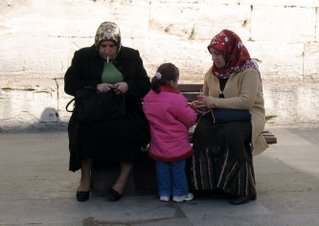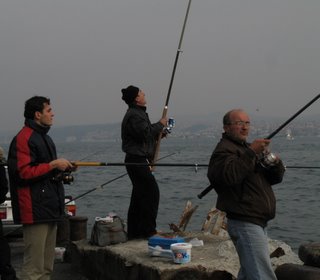Spain: Hills Like White Elephants



SPAIN:HILLS LIKE WHITE ELEPHANTS
Spain.—our very last port before home and it seemed pretty “easy” to delve into after the exotic ports and difficulty of communication in the Asian as well as other ports. But also, it was familiar; only four years ago we traveled with John and Hilary, Tom’s brother and sister-in-law, and though we visited a new city, our port city o0f Cadiz on the tip of Spain, we also revisited the town of Granada and its famous site, the Alhambra.
We spent the first two days in Cadiz, exploring the especially beautiful parks, many with gorgeous ocean views and botanical specimens from all over the world. Many of the trees came from the canary islands—and one they called a “ficus” was especially lovely—huge, huge entertwined trunks and branches (almost like a baobab) and big shiny leaves that looked like magnolia leaves. Of course there were Mediterranean palms and cactus and flowering shrubs (even though it’s winter here –it was still 60-70 degrees although VERY windy by one of the old castles, Santa Catalina whose appearance made us realize where the California “mission style” comes from. We toured the old town and its many shops and cafes and pedestrian shopping center, saw the remains of bodies from the Inquisition still plastered into old walls and were indeed awed by its mammoth cathedral—built of limestone and stone of petrified shell—in all of its baroque glory.
Inside it is beautifully baroque but almost entirely white—white stone and white columns and unlike most of the other cathedrals, the candlesticks and tabernacle and monstrance and trim was make of silver instead of gold . In the basement was a gigantic crypt with lots of saints and dignitaries buried there as well as a chapel to St. whose still “pure” body rested relatively uncorrupted in her glass reliquary for all to see. I must admit I’ve seen more relics of Catholic, Orthodox and Muslim holy people than ever before—or maybe just more multi-faith ones. And the cathedral museum had many costly and carved ivory and gold and embroidered church garments and crucifixes and tabernacles than I could have believed hadn’t been sent to the Vatican and its museums. The ivory pieces were huge and finely carved. Unfortunately, lunch time here is about 3—and dinner starts at about 9:30 and we could never find open restaurants at a time we wished to dine. It got dark at about four and the stores mostly all closed from 2- 5:30. Evidently they don’t take a siesta but do have their main meal then. We kept hoping someone would take us home for dinner!
The next three days we spent with Val and Roger Vetter,; he’s an ethnomusicologist who teaches at Grinell in Iowa and Val teaches T’ai Chi and ethnic dance. We took the train from Cadiz to Grenada so we could re-visit the Alahambra and the Moorish section of Albaicin. The trains in Spain (are mainly on the plain)—sorry, I couldn’t stop myself. Anyway the trains are comfortable; however on part of the journey we were annoyed by a group of adolescent hoodlums on their way to play soccer. They held LOUD constant conversations, smoked in the non-smoking train, stuck feet on windows and seats, threw things at each other, argued and went constantly to the bathroom—to smoke and/or shoot-up perhaps. No Spanish people said a word to them; I think they were a bit afraid. We complained but the conductor would “speak” to them and leave fast for a different car. But we got there, found a nice if not charming hotel and went sightseeing.
The next day we went up the huge hill to the palace buildings and fortress of Alhambra, reconquered by the Christians in 1492 while Christopher Columbus was busy exploring and Queen Isabella and King Ferdinand then expelled all the Jews and any Muslims in th4 area. Washington Irving, a romantic American writer was a diplomat here in 1829 and lived for a.while in rooms in the palace. It was probably his description in his Tales of the Alhambra that led to its renovation and its historical prominence . Actually his descriptions of the place still ring true, This is how he describes the famous Court of Lions:
There is no part of the edifice that gives us a more complete idea of its
Original beauty and magnificence than this, for none has suffered so
Little from the ravages of time. In the center stands the fountain famous
In song and story. The alabaster basins still shed their diamond drops,
And the twelve lions which support them cast forth their crystal streams
As in the days of Boabdil. The court is laid out in flower beds and
Surrounded by light Arabian arcades of open filigree work, supported by
Slender pillars of white marble. The architecture, like that of all other parts
Of the palace is characterized by elegance rather than grandeur, bespeaking
A delicate and graceful taste and a disposition to indolent enjoyment. When
One looks upon the fairy tracery of the peristyles and the apparently fragile
Fretwork of the walls, it is difficult to believe that so much has survived the Wear and tear of centuries….
It was a cold afternoon yet the palace and its decorations were worth a bit of discomfort. Afterward we went back down the hill for a snack—the wonderful hot chocolate and churros (for dunking) of southern Spain. Later that evening after a late (for us) dinner, we went to a small Spanish bar for real Flamenco—a great guitar player, male singer and female singer and dancer. The stage was tiny and the audience right there crammed in with drinks (and cigarettes) and sweat to watch this non-tourist performance for real aficionados. We were told that in the states while the cars whiz by broadcasting the deep bass of hip hop and rap, the young people here turn up their flamenco and bounce in their cars to this beat one that really didn’t get popular until the 1920s but still remains.
The train brought us “home” to the ship in Cadiz the next day, minus the soccer players to our infinite relief. Now…ten days across the Atlantic. We’ll see you all soon!!
DK









